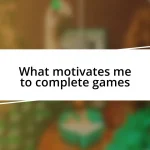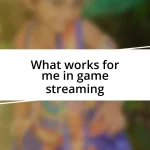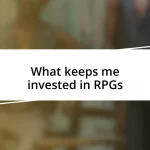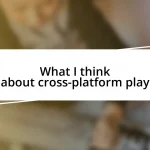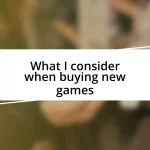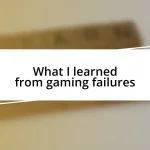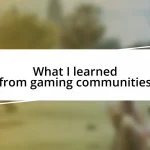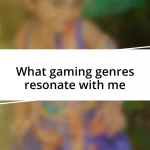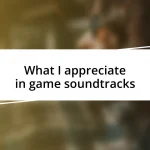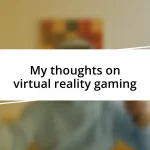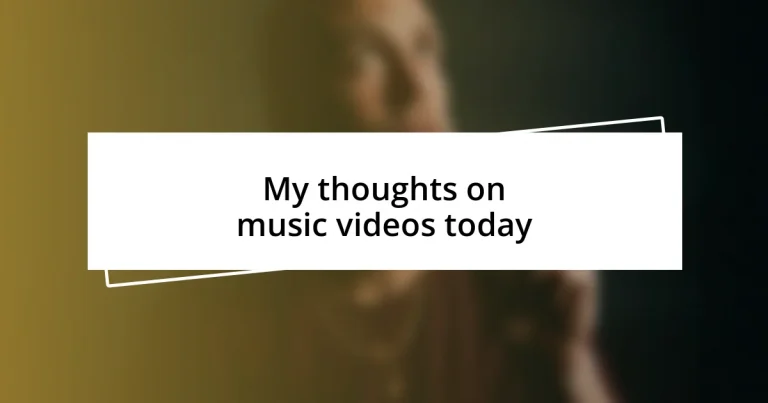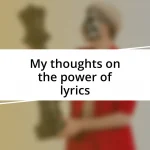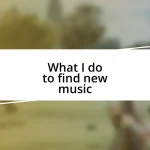Key takeaways:
- The evolution of music videos has shifted from simple promotional tools to complex artistic expressions, influenced by digital platforms and interactive storytelling.
- Modern music videos utilize diverse storytelling techniques and visual aesthetics, engaging viewers on emotional and personal levels while fostering community through social media interaction.
- The future of music videos is poised for greater interactivity, with potential advancements in virtual reality and personalized content driven by AI, enhancing viewer experiences and connections with artists.
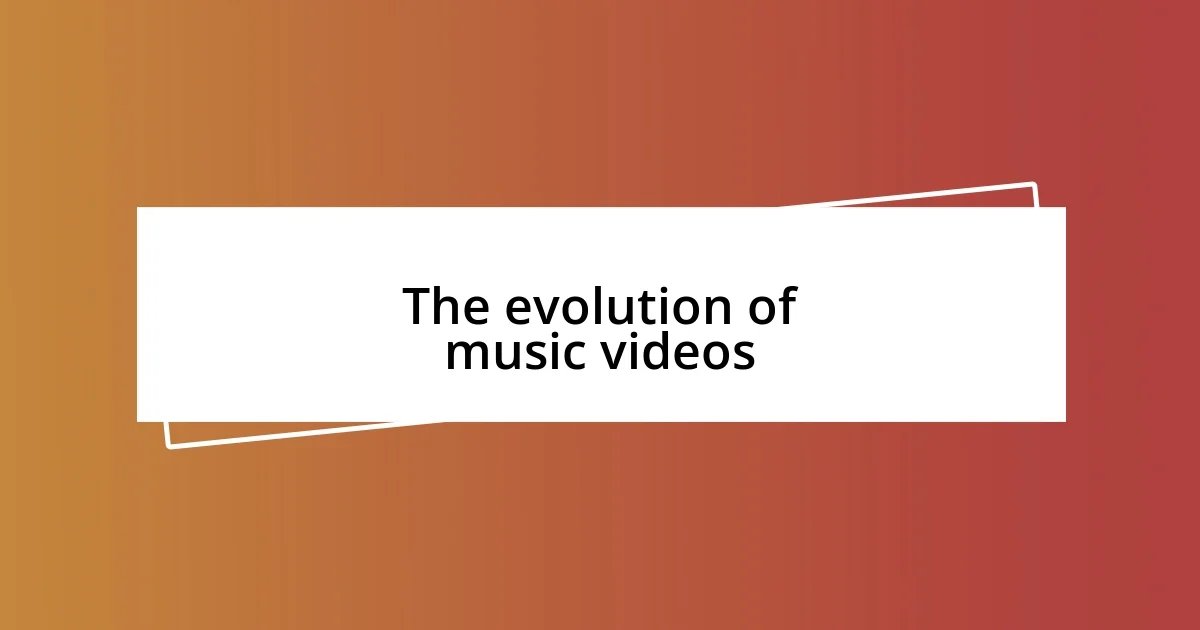
The evolution of music videos
The evolution of music videos has been nothing short of remarkable. I remember the excitement of gathering with friends, waiting for MTV to premiere a new video. It felt like an event—something that united fans in anticipation and sparked conversations about artistry and creativity. What was it about those first music videos that drew us in? Was it the storytelling, the visuals, or maybe it was that special way a song could come to life through imagery?
As technology advanced, so too did the complexity of music videos. The rise of digital effects brought us breathtaking productions that felt like mini-movies rather than just promotional tools. I recall watching Beyoncé’s “Single Ladies” and being struck by how it transformed simple choreography into a cultural phenomenon. It’s fascinating how these videos can influence fashion and dance trends, igniting conversations that ripple beyond music.
Today, the landscape is even more dynamic with platforms like YouTube shaping how we consume music. I can’t help but wonder how this instant access has changed our relationship with artists. With so much content available at our fingertips, do we savor music videos as much? Or has our attention shifted, making it harder to appreciate the artistry behind each clip? The evolution of music videos continues to provoke questions like these, engaging us in a dialogue about creativity in the digital age.
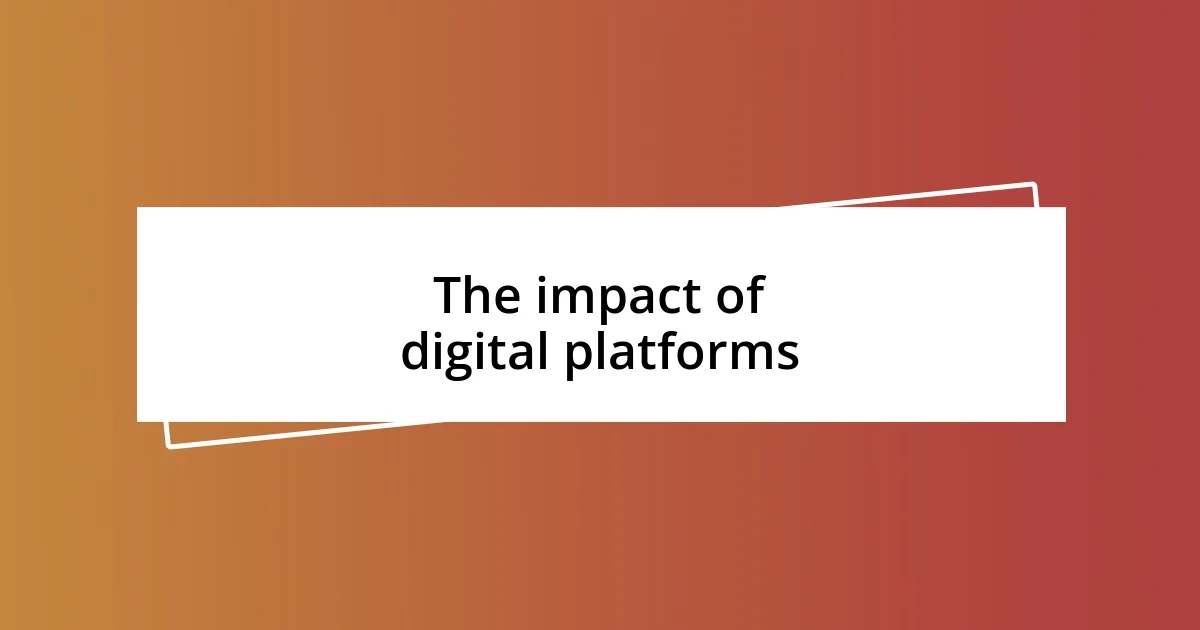
The impact of digital platforms
The rise of digital platforms has significantly transformed how we experience music videos. I often find myself scrolling through playlists on services like YouTube and Vevo, where the sheer volume of content can be overwhelming. It’s interesting to note that instead of waiting for a specific airtime, I can now binge-watch an artist’s entire catalog in one sitting. Yet, has the availability altered my appreciation for each piece, or has it merely enhanced my ability to discover new talent?
What strikes me the most is how these platforms foster a direct relationship between artists and fans. I remember the rush of excitement when an indie artist I loved released a music video online, which I could share with my friends instantly. This interaction creates a sense of community, as I can comment alongside others who feel the same way. But, does this immediate feedback influence how artists create? It’s intriguing to consider how they might craft videos to go viral, sometimes prioritizing views over artistic expression.
As we navigate this digital landscape, it’s clear that the impact of these platforms goes beyond mere viewership. The data showcases that social media integration amplifies video promotion, meaning that trends can shift rapidly based on algorithms. It leads me to ponder how this rapid content cycle affects both quality and creativity. Are artists feeling pressured to produce more frequently, sacrificing the depth of their work?
| Aspect | Impact of Digital Platforms |
|---|---|
| Content Accessibility | Instant access to music videos anytime, anywhere. |
| Artist-Fan Interaction | Direct feedback and community building through comments and shares. |
| Trend Influence | Viral content driven by algorithms shapes artistic choices. |
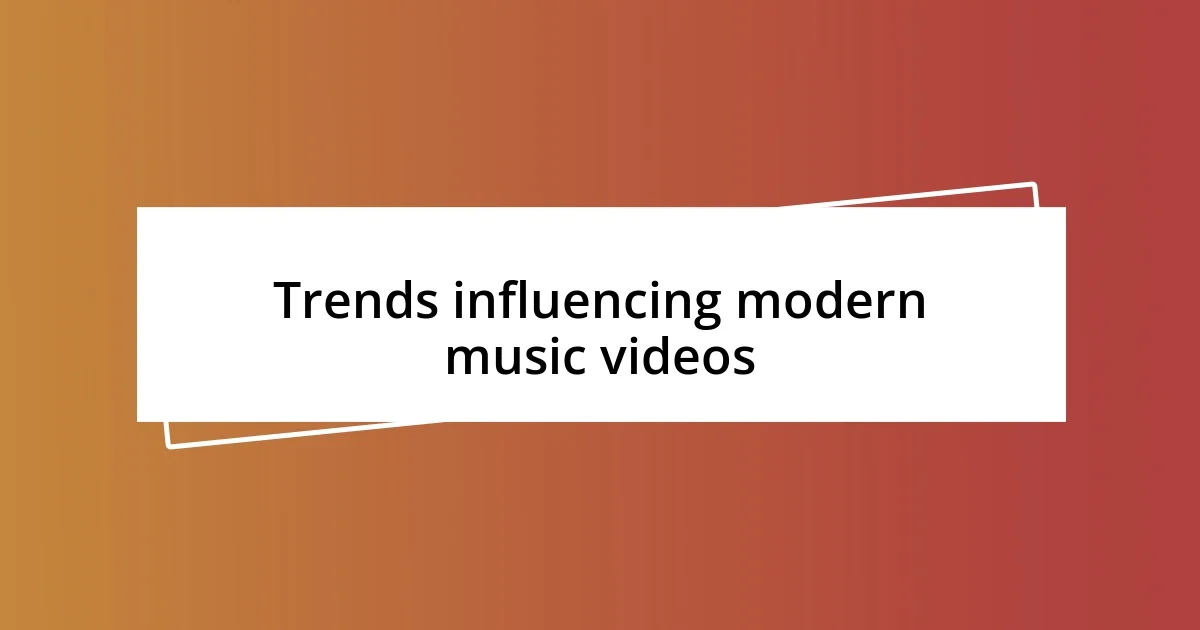
Trends influencing modern music videos
The trends influencing modern music videos today are as diverse as the artists producing them. One standout shift is the embrace of storytelling within short formats. I’ve noticed that many artists are weaving narratives into their videos that resonate more deeply with viewers. Take, for example, Childish Gambino’s “This Is America.” It’s not just a song; it’s a powerful commentary presented through striking visuals. That’s how music videos now function as a platform for social commentary, merging art with urgent real-world issues.
- Diversity in Representation: We see a broader range of artists and themes, reflecting the diverse world we live in.
- Interactive Experiences: Artists incorporate elements that encourage viewer participation, creating a more engaging experience.
- User-Generated Content: Many videos invite fans to contribute their own creativity, blurring the lines between artist and audience.
- Augmented Reality (AR) and Virtual Reality (VR): These technologies are being integrated, making experiences more immersive and interactive.
Additionally, I can’t help but feel nostalgic when I recall the pure joy of discovering a new music video. Now, I often find myself enchanted by visually stunning pieces that play with surreal aesthetics. Billie Eilish’s “When the Party’s Over” had such a haunting quality—its minimalistic design and emotional depth drew me in. The evolution of those visuals taps into my emotions and elevates a song’s message, showing that aesthetics in modern music videos aren’t just about flash; they can evoke a visceral response that lingers long after the video ends.
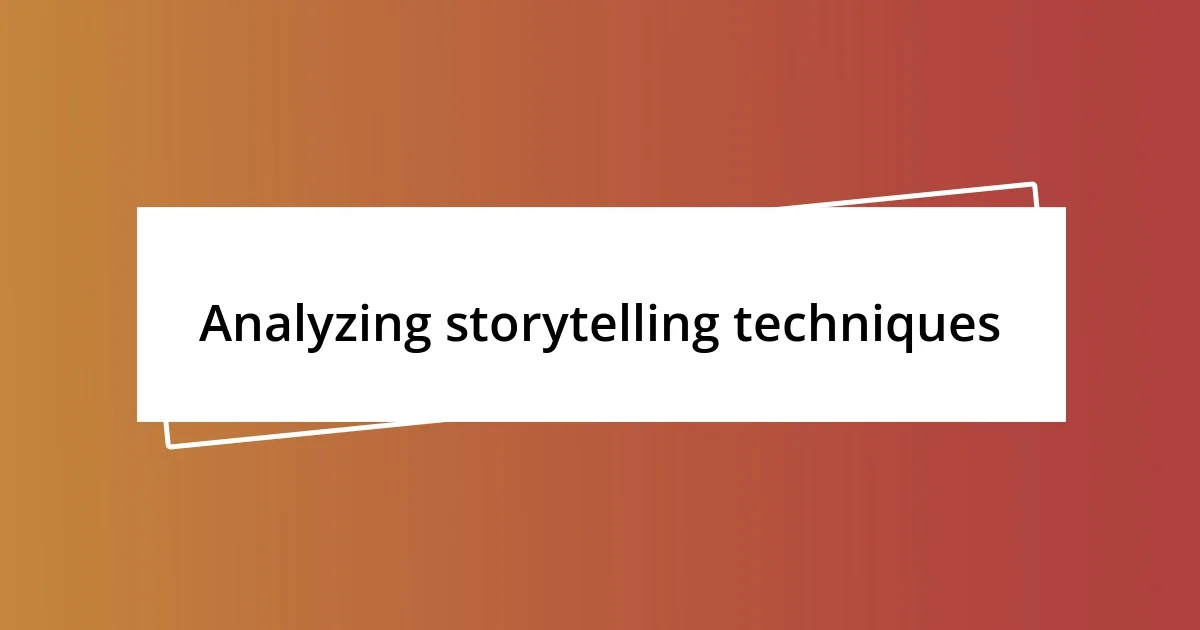
Analyzing storytelling techniques
When I think about storytelling techniques in modern music videos, what’s fascinating is how artists condense entire narratives into just a few minutes. I recently watched a video where the entire plot unfolded as a love story, evolving through various settings, each reflecting different emotional states. This ability to convey complex emotions within a brief visual aesthetic is something that hits me hard. It’s remarkable how a single scene can trigger memories or feelings from my own life, reminding me that storytelling in music videos can mimic the depth of a great film.
In my experience, the intertwining of visuals with musical storytelling often leads to a more profound connection with the audience. Take for instance the music video for “Everything I Wanted” by Billie Eilish. It portrays a dreamlike quality that resonates with feelings of anxiety and vulnerability. As I watched, I couldn’t help but recall times when I felt lost in my own world. The depiction of struggles through poignant imagery makes those songs feel more like a personal dialogue rather than just entertainment. This connection invites viewers to reflect on their own experiences, making the storytelling even more impactful.
Moreover, I’ve observed that many artists use recurring symbols or motifs to create a cohesive narrative thread. For example, in the video for “Lemonade” by Internet sensation Gucci Mane, the use of color and visuals not only reflects the song’s lyrics but also builds a world I’m eager to immerse myself in. These clever techniques encourage me to watch the video multiple times, searching for deeper meanings and reinterpreting the visuals in light of my feelings. It raises the question: how does repetition in storytelling enhance a viewer’s emotional journey? From my perspective, it ultimately fosters a connection that extends beyond the screen, making music videos an art form rich with personal resonance.
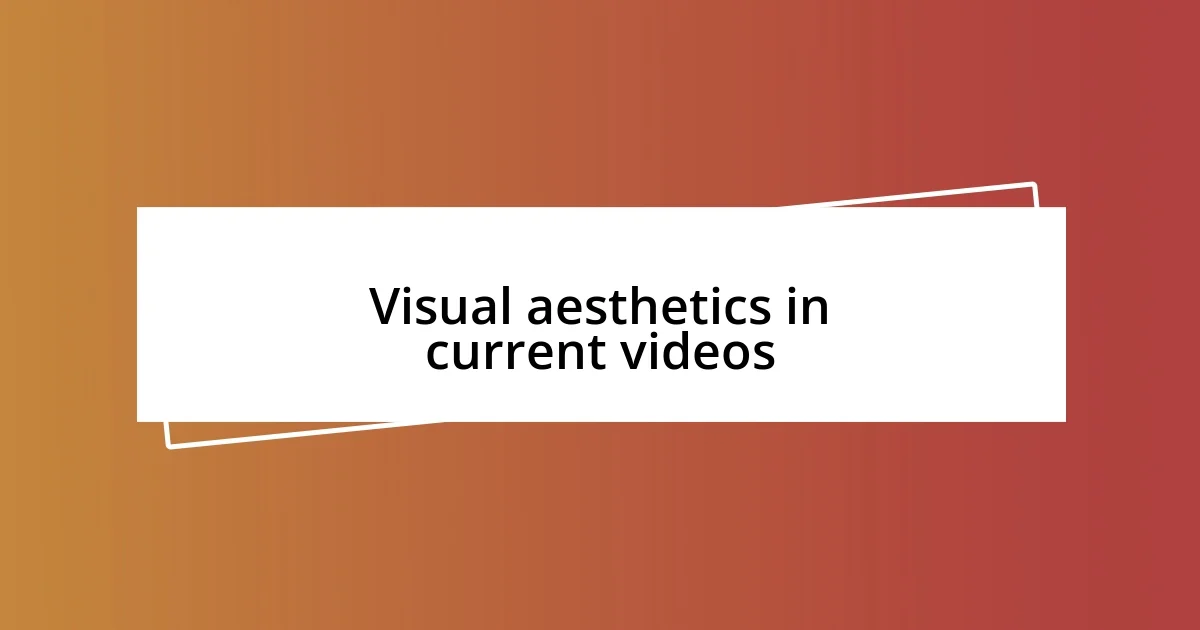
Visual aesthetics in current videos
Visual aesthetics play a pivotal role in how music videos connect with audiences today. I often find myself captivated by the use of striking colors and innovative filming techniques. For example, I recently watched a video where the vibrant hues seemed to change with the beat, enhancing my emotional experience. This attention to detail creates a multisensory engagement that pulls me in, allowing me to feel the music on a deeper level.
One of the things I love about current music videos is the use of surreal visuals. They transport me to different worlds and often evoke a sense of wonder or introspection. In a recent video, I was struck by a sequence where the artist floated through a dreamscape filled with unexpected elements. It made me ponder: how do these bizarre landscapes reflect our inner thoughts and feelings? I believe they bring a certain truth to the emotional state being portrayed, transcending the mere combination of sounds and visuals.
Moreover, the simplicity of some contemporary videos can be just as impactful. There’s something profound about minimalistic backgrounds that let the music and the artist take center stage. I remember watching a video that used a single, static shot to focus on the performer’s raw emotion. It felt like a window into a private moment, inviting me to share in that vulnerability. This approach not only emphasizes authenticity but also challenges us to appreciate the subtleties. How does this kind of visual storytelling resonate with our desire for genuine connection in an increasingly digital world? For me, it highlights that at the core of every music video is an opportunity to really feel the music—something that remains timeless amidst ever-evolving trends.

The role of audience engagement
The way artists engage their audience today is truly fascinating. I remember scrolling through my feed and coming across a music video that invited viewers to choose different storylines, depending on their preferences. It felt as if I wasn’t just a passive observer; I was part of the narrative, shaping the experience to reflect my own emotions. This kind of interactive storytelling adds layers to the viewing experience, transforming it into something uniquely personal.
Another aspect that continually amazes me is how social media amplifies audience engagement. For example, I once participated in a challenge where fans reimagined scenes from a popular music video, sharing their versions online. This not only created a buzz but also fostered a sense of community among fans. It makes me wonder: how does this collaborative spirit enhance our connection to the music and artists we admire? From my perspective, it transforms music videos from mere entertainment into a collective experience that encourages creativity and emotional investment.
Additionally, I have noticed that behind-the-scenes content also plays a crucial role in audience engagement. When an artist shares snippets of the creative process on platforms like Instagram or TikTok, it pulls me in even further. I remember when a favorite musician shared a video of their struggles during the production of their latest album. That glimpse into their journey made me appreciate their artistry in a much deeper way. How do these personal stories impact our connection with the artist? I believe it fosters a sense of intimacy, reminding us that behind every music video is a story of perseverance, emotion, and shared humanity.
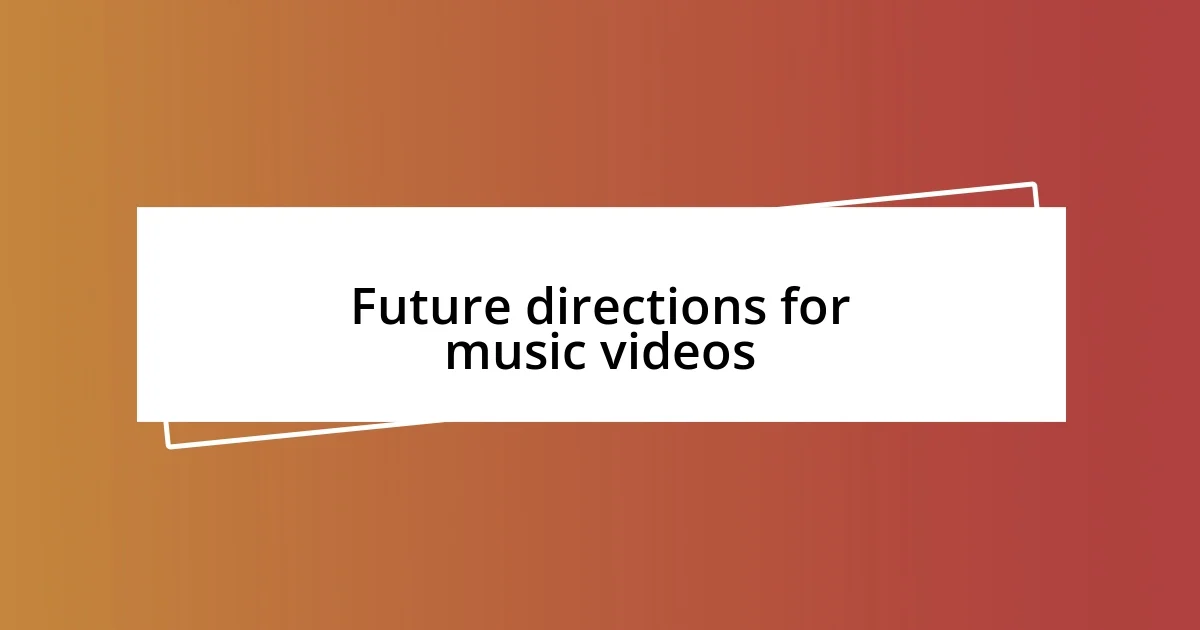
Future directions for music videos
As I look toward the future of music videos, I can’t help but think about the potential for even greater interactivity. Imagine a world where viewers could not only choose their viewing path but also influence the music being played. I recall one time when I stumbled upon a livestream concert that allowed fans to vote on which songs to play next. It was exhilarating! This dynamic could transform music videos into collaborative experiences, fostering a deeper connection between the artist and their audience.
With the rise of virtual and augmented reality, the possibilities seem limitless. I had the chance to try a VR music experience recently, where the artist’s world enveloped me, making the song feel almost palpable. What if music videos could fully immerse us in an artist’s vision? This technology could create spaces where the viewer isn’t just watching but experiencing the narrative firsthand. This evolution could lead to a deeper emotional connection that transcends the screen.
Furthermore, I believe we might see a shift towards more personalized content through AI. I remember feeling surprised when a recommendation algorithm introduced me to a music video tailored to my specific tastes. How practical would it be to have music videos that adapt to our individual preferences? This could make the viewing experience so much more meaningful, aligning perfectly with how we relate to music in our daily lives. I genuinely believe that as technology evolves, so will the ways we consume and connect with music videos.
